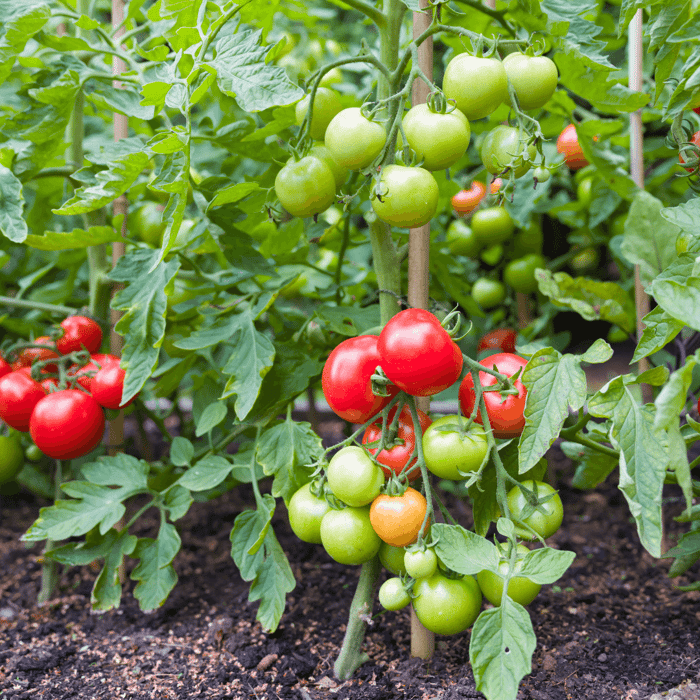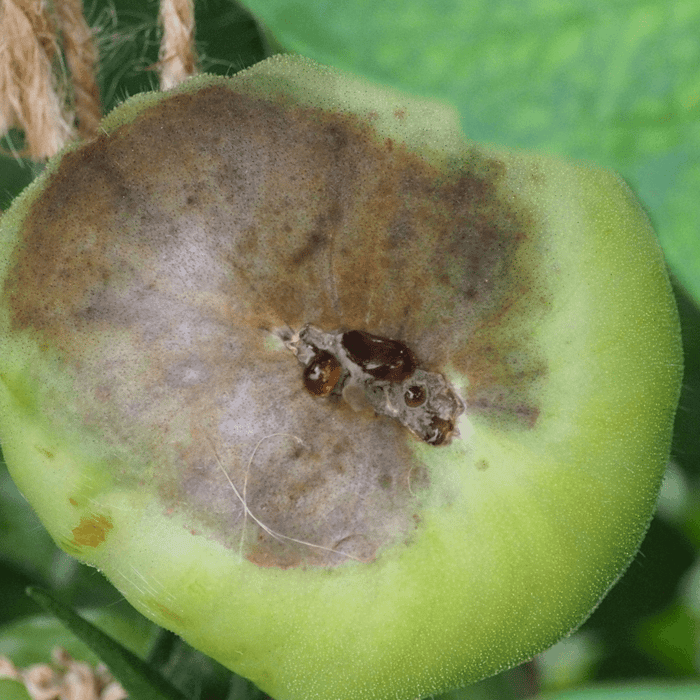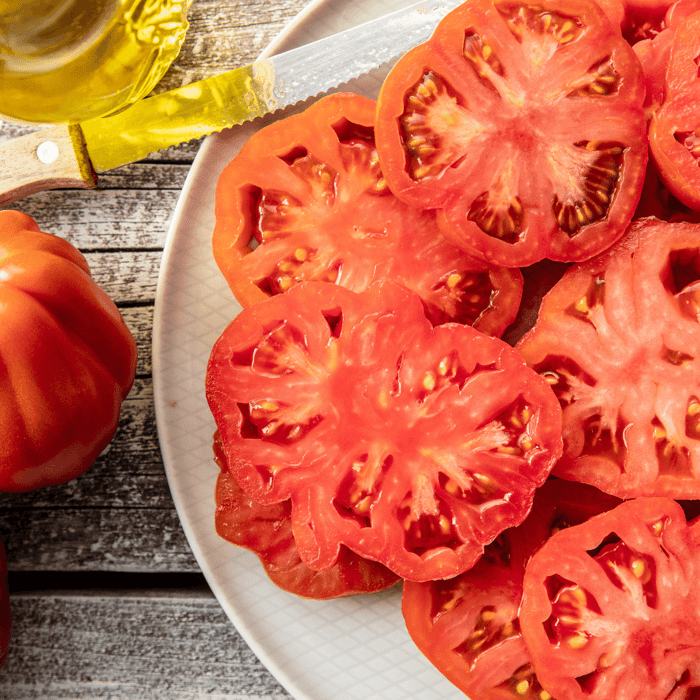Tomatoes are a popular and versatile fruit used in various dishes, from salads to sauces. However, many gardeners have experienced the frustration of watching their tomato plants produce beautiful green fruit only to see them drop off the vine before they ripen. This phenomenon is known as fruit drop and can be caused by several factors. So, what causes tomatoes to drop fruit anyway? Let's find out!
A Brief Overview of Tomato Plants and Fruit Dropping
To understand why tomato plants drop fruit, it helps to first understand tomato plants and how they grow. Tomato plants are members of the nightshade family and are native to South America.
They typically grow as sprawling vines or bushes, with dark green leaves and slightly hairy. The fruit of the tomato plant is technically a berry and comes in various sizes, shapes, and colors.
When a tomato plant blossoms, it will eventually produce small green fruits that enlarge as they mature. If all goes well, these fruits will continue to grow until they reach full size and ripen into juicy red tomatoes ready for harvest.
However, sometimes things don't go according to plan. A common problem that tomato growers encounter is when their plants start dropping immature fruit before it has had time to ripen on the vine.
Heirloom Tomato Seeds for Planting | 16 Variety Pack
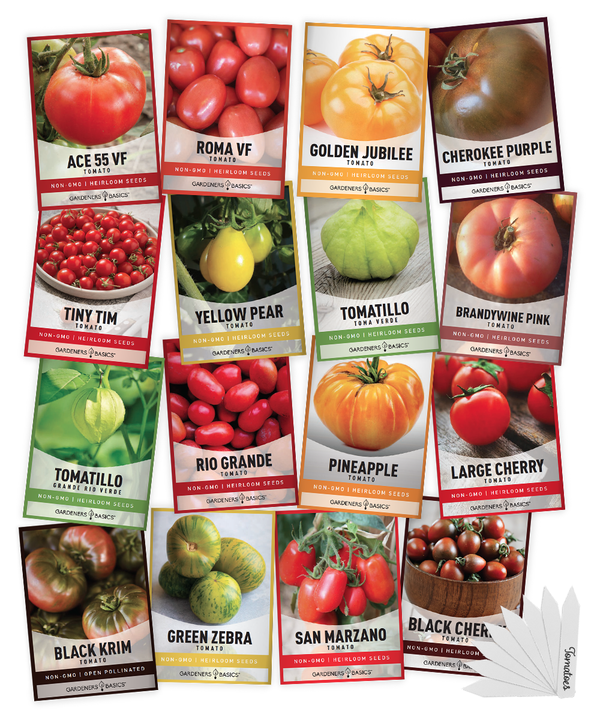
$19.95
The Ultimate Tomato Seed Variety Set - 16 Heirloom, Non-GMO Tomato Varieties for Your Home Garden Introducing our 16 Tomato Seeds Variety Pack, a must-have collection for any gardening enthusiast or professional grower! This premium seed assortment includes a diverse selection… read more
The Importance of Understanding What Causes Tomatoes to Drop Fruit
Fruit drop can be frustrating for gardeners who have put time and effort into growing their tomatoes. It means less yield at harvest time and adds uncertainty over when harvesting should occur or if there will ever be a harvest! The causes behind this phenomenon vary widely, but understanding them is essential for any gardener who wants to maximize their tomato crop yield by preventing or mitigating fruit drop.
This article will explore the most common causes of tomato fruit drop and provide some suggestions for what you can do to prevent it from happening in the first place. We will cover environmental factors, nutrient deficiencies, pests and diseases, genetics and plant physiology, and management strategies that can be used to minimize fruit drop.
By understanding the factors contributing to this problem, you'll be better equipped to grow healthy tomato plants with plenty of flavorful fruit. In the next section, we'll look at environmental factors that can cause tomatoes to drop their fruit.
Environmental Factors
Tomatoes are a popular plant for home gardeners, but they can be finicky regarding environmental conditions. Several factors in the environment can cause tomato plants to drop fruit prematurely. Understanding these factors is key to preventing fruit drop and ensuring a healthy harvest.
Temperature Fluctuations and Extremes
Tomatoes are sensitive to temperature fluctuations, particularly during their flowering and fruiting stages. The plant may drop its fruit if temperatures fluctuate too much or become too extreme (too hot or too cold). Temperature extremes can also cause blossom-end rot, a condition where the bottom of the tomato turns black and leathery.
To prevent temperature-related fruit drops, it's important to keep an eye on weather forecasts and protect your plants as necessary. Consider using shade cloth, row covers during hot spells, or covering plants with blankets or plastic sheeting during cold snaps.
Drought or Overwatering
Inconsistent watering is one of the most common causes of tomato fruit drop. Tomatoes need regular moisture to thrive, but overwatering can be as detrimental as underwatering. If you're experiencing drought conditions, ensure your tomatoes get enough water.
You may need to water them more frequently to compensate for dry soil. On the other hand, if you've been experiencing heavy rains, ensure excess water drains away from your plants so they don't become waterlogged.
Humidity Levels
Ambient humidity levels can also affect tomato fruit production. High humidity levels can lead to poor pollination and an increased risk of fungal disease, which can cause fruit drop.
To mitigate high humidity levels around your tomato plants, consider pruning back leaves and branches to improve air circulation. You can also provide additional ventilation with fans or place your tomato plants in a location with good airflow.
Light Exposure
Tomatoes require a certain amount of sunlight to produce fruit, but too much direct sun can cause fruit drop. This is because high levels of UV radiation can damage the plant's DNA and interfere with its ability to produce fruit. To prevent light-related fruit drops, consider shading your plants during the hottest part of the day or using reflective mulch around the base to bounce some of the sunlight back towards the leaves and blossoms.
Environmental factors such as temperature fluctuations and extremes, drought or overwatering, humidity levels, and light exposure can all contribute to tomato fruit drop. You can enjoy a healthy and abundant harvest by considering these factors and mitigating their impact on your plants.
Tomato Seed Assortment | 8 Variety Pack
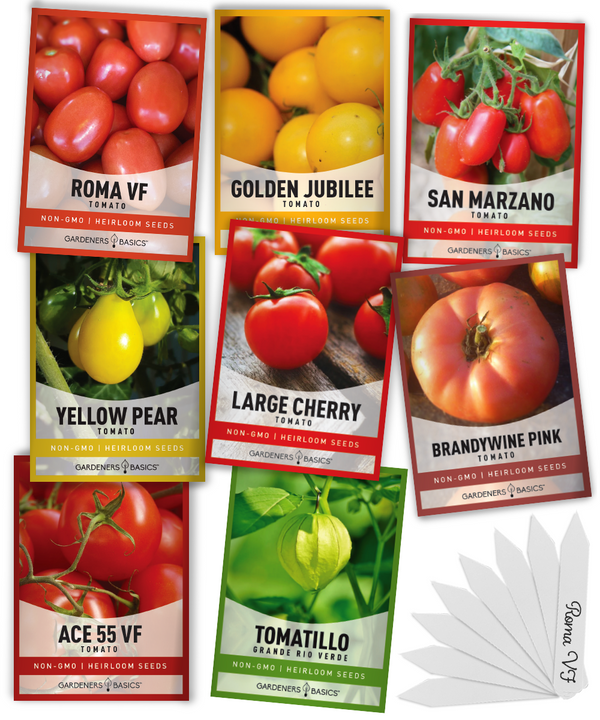
$15.95
8 Tomato Seeds Variety Pack – Heirloom, Non-Hybrid, Open-Pollinated, Non-GMO – Perfect for Home Gardens! Unlock the secrets to a thriving tomato garden with our premium 8 Tomato Seeds Variety Pack! Carefully curated for tomato lovers and gardening enthusiasts alike, this… read more
Nutrient Deficiencies
Lack of Nitrogen
Nitrogen is a vital nutrient for plant growth, as it plays a crucial role in producing chlorophyll, which is responsible for photosynthesis. Without sufficient nitrogen, tomato plants will struggle to grow and produce fruit. Symptoms of nitrogen deficiency include yellowing leaves that start from the bottom of the plant and work their way up.
The leaves may appear smaller than usual, and growth may be stunted. To prevent nitrogen deficiencies, it's essential to ensure that your soil is rich in organic matter.
Organic matter can help improve soil structure and increase its ability to hold onto nutrients like nitrogen. You can add natural fertilizers like compost or manure to your soil to provide a steady nitrogen supply throughout the growing season.
Lack of Phosphorus
Phosphorus is another essential nutrient for tomato plants, as it helps with root development, fruit formation, and overall plant growth. A lack of phosphorus can lead to stunted growth and poor fruit set.
Symptoms of phosphorus deficiency include dark green leaves that are small and narrow. Ensure your soil has a neutral pH (around 7) to prevent phosphorus deficiencies.
Soil that is too alkaline or acidic can impede phosphorus uptake by the plant's roots. Adding bone meal or rock phosphate to your soil can also help provide a steady phosphorus supply throughout the growing season.
Lack of Potassium
Potassium helps regulate water movement in tomato plants and aids in disease resistance. A lack of potassium can cause yellowing or browning on leaf edges, weak stems, and slow growth.
To prevent potassium deficiencies in your tomatoes, ensure adequate drainage by providing deep irrigation only when necessary; excessive watering with potash-rich fertilizers may also lead to potassium deficiency. Fertilizing with compost or manure can also help replenish potassium in the soil.
Imbalanced Soil pH Levels
Soil pH is a measure of how acidic or alkaline the soil is. Tomato plants prefer slightly acidic soil with a pH range of 6.0–6.8. Imbalances in pH can cause nutrient deficiencies, including those mentioned above.
To prevent imbalanced soil pH levels, test your soil regularly using a kit from your local nursery; this will also give you an indication of what type of fertilizer to use for the best results. If your soil is too acidic, it may be necessary to add lime; if too alkaline, you can add sulfur or peat moss to lower the pH level slowly over time.
Nutrient deficiencies are one of the primary causes of fruit drop in tomato plants. Ensuring that your tomatoes have access to proper nutrients like nitrogen, phosphorus, and potassium and maintaining the correct acidity levels in the soil are essential for healthy plant growth and high fruit yields. Using organic fertilizers such as compost and manure and regularly monitoring your soil's nutrient levels throughout the growing season can help prevent fruit drops from nutrient deficiencies in your tomato plants!
Pests and Diseases
Common Pests That Cause Fruit Drop
Tomato plants are susceptible to various pests, some of which can cause fruit drop. Aphids, for example, are small insects that suck the sap out of plant tissues.
They tend to feed on the undersides of leaves and can cause leaf yellowing and curling, stunted growth, and even death if left unchecked. In severe infestations, aphids can also cause tomato fruits to drop prematurely.
Spider mites are another common pest that can cause fruit drops in tomato plants. These tiny arachnids feed on plant sap and leave behind a web-like substance on leaves and stems.
Like aphids, spider mites can lead to stunted growth and leaf yellowing/curling. They can also directly damage developing tomato fruits by piercing them with mouthparts.
Other pests that can contribute to fruit drop include whiteflies (which transmit viral diseases), thrips (which scar fruits), and fruit worms (which tunnel into developing tomatoes). Preventative measures such as regular monitoring, maintaining healthy plants through sound cultural practices like watering regularly or removing affected branches, and using insecticidal soaps/pesticides when necessary may be implemented.
Rare Tomato Seeds | 5 Variety Pack
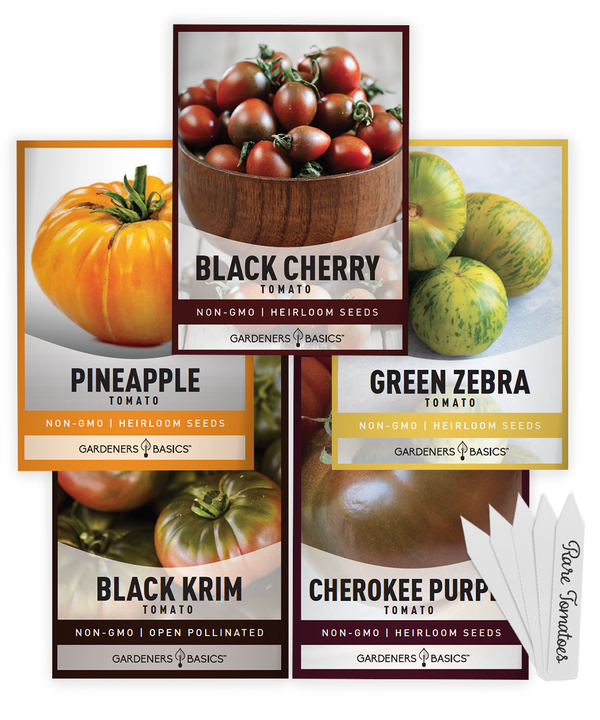
$9.95
Grow Unique Tomatoes: 5 Rare Tomato Seeds Collection for Your Garden Introducing our 5 Rare Tomato Seeds Variety Pack, a must-have for every tomato lover and avid gardener! This premium collection features a curated selection of rare heirloom tomato seeds to… read more
Fungal Diseases That Affect Tomato Plants
Several fungal diseases affect tomato plants causing multiple symptoms, including fruit drop. Early blight is one such fungal disease caused by Alternaria solani fungus that leads to stem lesions that eventually cascade onto the leaves before reaching the actual fruit causing the premature falling off of tomatoes from the plant. Fusarium wilt is another fungal disease caused by Fusarium oxysporum, which infects through roots and enters into xylem vessels leading up to clogging, which ultimately causes wilting of leaves.
This wilted area then becomes infected with other microorganisms, causing the rotting away of fruits and making them fall off the plant even before they mature. Septoria leaf spot is a third fungal disease caused by Septoria lycopersici, which creates small dark spots on leaves, eventually leading to leaf dropping.
This fungus affects fruiting as well and causes early fruit drop. Management of fungal diseases can include removing or pruning affected areas to prevent the spread of infection.
Fungicides can also be used as a preventative measure, but selecting those that target the specific type of fungus causing the issue is essential. Additionally, maintaining good cultural practices like watering at the soil level rather than overhead watering so as not to wet foliage can lessen the probability of infection.
Genetics and Plant Physiology
Inherent Traits that Make Some Tomato Varieties More Prone to Fruit Drop
Tomatoes are a diverse group of plants, with hundreds of varieties differing in color, size, taste, and texture. However, not all tomatoes are created equal regarding their ability to hold onto their fruits.
Certain traits can put some tomato plants at higher risk of fruit drop than others. One example is the shape of the fruit.
Tomatoes with elongated or pear-shaped fruits tend to be more prone to fruit drop than those with round or cherry-shaped fruits. This is because the weight distribution on these fruits is uneven, making them more likely to detach from the stem.
Another factor is the plant's growth habit. Indeterminate tomato plants – those that continue growing and producing new flowers and fruits throughout the season – are more susceptible to fruit drop than determinate types with a fixed number of flowers and fruits per stem.
This is because indeterminate plants require more energy to maintain their growth, which can divert resources away from developing and supporting existing fruits. Certain hybrid varieties are bred for high yield but may sacrifice other traits such as disease resistance or sturdy stem strength to keep tomatoes attached securely.
Hormonal Imbalances Within The Plant
Tomato plants produce various hormones that regulate plant growth, development, and responses to environmental stimuli such as light, temperature changes, or water availability. However, certain imbalances can trigger physiological reactions leading to premature fruit drop.
One such hormone imbalance occurs when the plant produces too much abscisic acid (ABA), signaling the plant is under stress or facing unfavorable conditions. ABA stimulates ethylene production in tomato tissues, which can cause fruit ripening and signal early abscission causing premature falling off.
Another hormone in tomato fruit set is auxin, which helps control plant tissue growth and differentiation. When the auxin concentration is too low, flowers may not be adequately pollinated or develop into fruits that are viable and attached securely.
This may result in a flower drop before any fruit has formed. Cytokinins are hormones that promote cell division and differentiation in plants.
A deficiency in cytokinin levels can lead to poor development of fruits and the formation of abscission zones – areas where fruits detach more easily from the stem. A tomato's ability to hold onto its fruit is influenced by various factors such as genetics, plant physiology, environmental cues, or maintenance practices.
Some varieties are inherently more susceptible to fruit drop due to their shape or growth habit, while hormonal imbalances within a plant can affect its fruit setting and retention. Understanding these factors can help gardeners choose suitable tomato varieties or implement management strategies to reduce the risk of premature fruit loss.
Tiny Tim Tomato Seeds
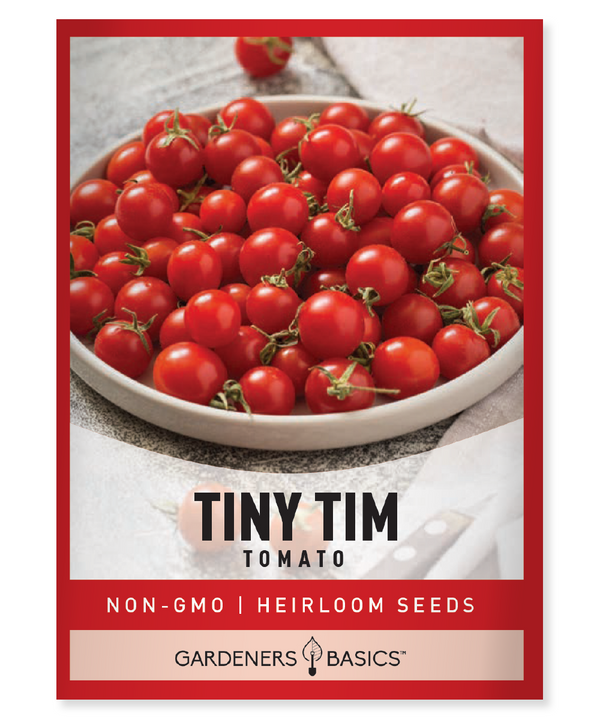
$2.49
Tiny Tim Tomato Seeds – Heirloom, Non-GMO, Non-Hybrid, Open-Pollinated | Perfect for Containers and Small Spaces Grow your own delicious, bite-sized cherry tomatoes with our premium Tiny Tim Tomato Seeds! These heirloom, non-GMO, non-hybrid, and open-pollinated seeds produce a compact,… read more
Management Strategies
Best practices for preventing fruit drop
Tomatoes are a popular garden crop because they are relatively easy to grow. However, even with the best intentions, tomato plants can still experience fruit drop. To prevent this from happening, gardeners can follow a few best practices.
Firstly, it is important to provide regular and consistent watering to tomato plants. Erratic watering schedules can cause stress on the plant, which can lead to fruit drops.
It is recommended to water deeply once or twice a week, depending on rainfall levels. Gardeners should also aim to water in the morning or early afternoon when the sun is not as intense and evaporation rates are lower.
In addition to proper watering techniques, fertilization is key in preventing tomato fruit from dropping prematurely. A balanced fertilizer that contains nitrogen, phosphorus, and potassium will help promote healthy growth and development of the plant.
Gardeners should follow label instructions carefully when applying fertilizer and avoid over-fertilizing, which can lead to chemical burns on the plant. Other preventative measures include providing ample space between each plant (at least 2-3 feet apart), staking or caging plants for support, and promptly removing any diseased leaves or branches.
Ways to mitigate damage once it occurs
Despite our best efforts, there may be times when fruit drops cannot be prevented entirely. In these cases, there are still some ways that gardeners can try to mitigate damage.
The first thing gardeners should do if they notice signs of fruit drop is examined their watering habits. They should adjust their watering schedule accordingly if they suspect overwatering or underwatering may cause the issue.
Another strategy for mitigating damage is pruning affected branches off of the plant. This removes diseased tissue and redirects energy from lost fruits toward the remaining fruits.
When pruning, use clean and sharp pruning shears to avoid causing further damage to the plant. Gardeners may also want to consider using a foliar spray treatment, such as an organic fungicide, to help combat any fungal diseases that may be present on the plant.
It is best to do this early in the morning or late in the afternoon when temperatures are mild, and wind speeds are low. If gardeners notice pests such as aphids or spider mites on their tomato plants, they should immediately use insecticidal soap or neem oil.
These treatments will help control the pest population before it can cause significant damage. By following these best practices for preventing tomato fruit drop and implementing these strategies for mitigating damage once it occurs, gardeners can help ensure a successful harvest of delicious homegrown tomatoes.
Best San Marzano Tomato Seeds For Sale
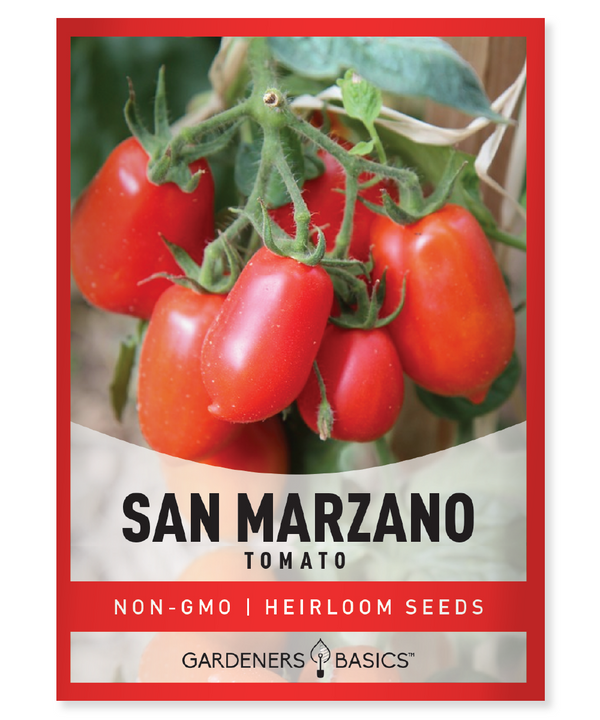
$2.49
Grow Authentic Heirloom San Marzano Tomatoes – Easy to Grow Non-GMO Seeds Our San Marzano Tomato Seeds are the perfect choice for any home gardener looking to grow authentic, high-quality tomatoes. These heirloom, non-GMO, non-hybrid, open-pollinated seeds produce the renowned San… read more
Conclusion of What Causes Tomatoes to Drop Fruit
Tomatoes are a staple crop in many home gardens and farms. They are loved for their taste, versatile uses, and nutritional value.
However, when fruit drop occurs, it can be frustrating and disappointing. Understanding the various factors that cause fruit drop is crucial to preventing it from happening in the first place and mitigating its effects when it does occur.
Environmental Factors
Temperature fluctuations, drought, overwatering, or exposure to humidity levels can all contribute to fruit drop. It is essential to monitor these variables by monitoring soil moisture levels, adjusting watering schedules based on weather patterns, or investing in shade cloths to protect plants from harsh sunlight during extreme heat.
Nutrient Deficiencies
Lack of nitrogen, phosphorus, or potassium can lead to poor tomato plant growth and development. Soil testing is one way to determine if plants lack specific nutrients necessary for healthy growth. Amendments such as manure or compost can help boost soil fertility.
Pests and Diseases
Pests such as aphids or spider mites feed on tomato plants, causing them stress and producing fruit drops. Fungal diseases such as Verticillium wilt also lead to fruit drop. Prevention measures like crop rotation and timely spraying of insecticides are essential in controlling pests, while early detection of fungal diseases is necessary for treatment.
Genetics and Plant Physiology
The inherent traits within specific varieties may make them more susceptible than others to dropping fruits with age or during high temperatures. Hormonal imbalances within tomato plants due to pruning practices that affect branching angles may also play a role in inducing stress leading to fruit dropping.
Management Strategies
Prevention remains the best cure for tomatoes that experience fruit drop due to water stress, temperature fluctuations, or nutrient deficiencies which calls for regular watering and fertilizing with balanced nutrients. Timely pruning of no longer productive branches can reduce plant stress leading to fruit drop.
Shading plants and using pest control measures are also helpful in preventing fruit drops. The causes of tomato fruit drop vary, ranging from environmental factors to genetics and plant physiology.
By understanding the different factors that contribute to fruit drop, gardeners can take proactive steps to prevent it from happening in their gardens and farms or mitigate its effects when it does occur. With proper management practices like timely maintenance and monitoring soil moisture levels, pests, or disease control measures, gardeners can ensure a bountiful harvest free from disappointing occurrences such as tomato fruit drops.
 Frequently Asked Questions about What Causes Tomatoes to Drop Fruit
Frequently Asked Questions about What Causes Tomatoes to Drop Fruit
Q1: Why do my tomatoes drop fruit before they are ripe?
A1: Several reasons can cause tomatoes to drop fruit prematurely, including temperature fluctuations, inconsistent watering, nutrient deficiencies, and stress from pests or diseases. Identifying the cause can help address the issue and prevent future fruit drops.
Q2: How do temperature fluctuations cause fruit drop in tomatoes?
A2: Tomatoes are sensitive to temperature changes; extreme temperatures can stress the plants, leading to fruit drop. Ideal daytime temperatures for tomatoes range from 70°F to 85°F (21°C to 29°C), while nighttime temperatures should be between 60°F and 70°F (15°C to 21°C). The plants may respond by dropping fruit if temperatures drop below or rise above these ranges.
Q3: Can inconsistent watering cause tomatoes to drop a fruit?
A3: Inconsistent watering can stress tomato plants and cause them to drop fruit. Maintaining a consistent watering schedule is important, providing the plants with deep watering sessions every few days rather than shallow, frequent watering. This helps to promote strong root growth and overall plant health.
Q4: What nutrient deficiencies can cause tomatoes to drop fruit?
A4: A lack of essential nutrients can lead to tomato fruit drop. Some common deficiencies include nitrogen, phosphorus, potassium, and calcium. To address these issues, provide your plants with a balanced, slow-release fertilizer and maintain proper soil pH levels.
Q5: How do pests and diseases contribute to fruit drop in tomatoes?
A5: Pests and diseases can cause significant stress to tomato plants, leading to fruit drop. Common pests include aphids, whiteflies, and hornworms, while diseases such as early blight, late blight, and fusarium wilt can also affect your plants. Regularly inspect your plants for signs of pests or diseases and take appropriate measures to treat and prevent these issues.
Q6: How can I prevent my tomato plants from dropping fruit?
A6: To prevent fruit drop in tomatoes, maintain consistent watering and fertilization practices, and provide adequate plant support. Also, be mindful of temperature fluctuations and maintain the ideal temperature range for tomatoes. Regularly inspect your plants for signs of pests or diseases, and take appropriate measures to treat and prevent these issues.
Q7: Can pruning tomato plants help reduce fruit drop?
A7: Pruning can help improve air circulation and reduce the risk of disease, which can help prevent fruit drop. However, excessive pruning can also cause stress and lead to fruit drop. Remove diseased, damaged, or unproductive branches and leaves, and avoid over-pruning your plants.
Cherokee Purple Tomato Seeds
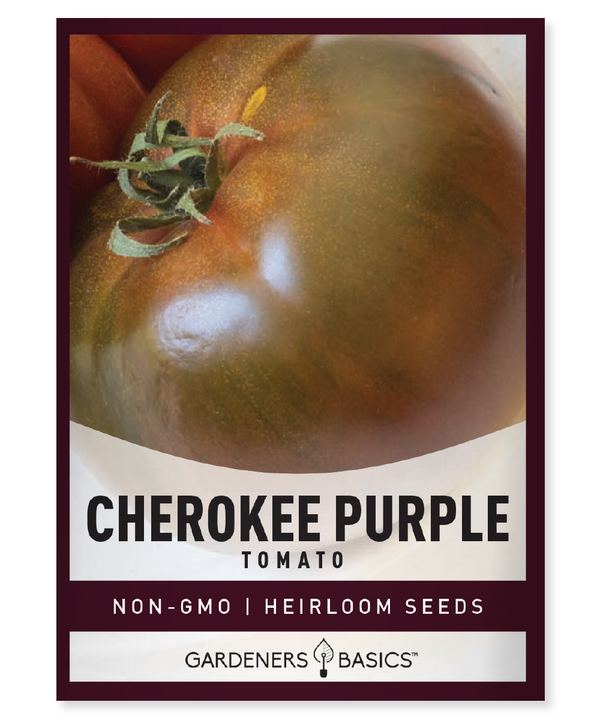
$2.49
Cherokee Purple Tomato Seeds - Heirloom, Non-GMO, Non-Hybrid, Open-Pollinated Cherokee Purple Tomato seeds produce one of the most beloved heirloom tomato varieties, prized for their rich, smoky flavor and stunning deep purple-red hue. Perfect for home gardens and tomato enthusiasts,… read more
Q8: Can pollination issues cause fruit drop in tomatoes?
A8: Yes, inadequate pollination can lead to fruit drop in tomatoes. Tomatoes are self-pollinating but rely on wind or vibrations to release pollen from the anthers to the stigma. If pollination is incomplete, the fruit may fail to develop correctly and eventually drop. Encouraging pollinators, like bees, or gently shaking the plants during the day can help improve pollination rates.
Q9: Can over-fertilizing cause tomatoes to drop fruit?
A9: Over-fertilizing, particularly with nitrogen-rich fertilizers, can lead to excessive vegetative growth at the expense of fruit production. This can cause stress on the plants and lead to fruit drop. Always follow the recommended application rates for fertilizers and consider using a balanced, slow-release fertilizer to provide a steady supply of nutrients.
Q10: How do I know if my tomato plants receive enough sunlight?
A10: Tomato plants require at least 6 to 8 hours of direct sunlight daily for optimal growth and fruit production. If your plants do not receive enough sunlight, they may become weak and susceptible to stress, leading to fruit drop. Monitor the sunlight exposure in your garden and consider relocating your plants to a sunnier spot if necessary.
Q11: Can transplant shock cause tomatoes to drop a fruit?
A11: Transplant shock can cause stress to tomato plants, leading to fruit drop. To minimize transplant shock, harden off seedlings gradually by exposing them to outdoor conditions for a few hours each day, gradually increasing the duration over a week. When transplanting, try to minimize root disturbance and keep the plants well-watered to help them establish quickly.
Q12: Are there any tomato varieties more resistant to fruit drops?
A12: While fruit drop can affect all tomato varieties, some cultivars may be more resistant to certain stress factors. Choosing disease-resistant or heat-tolerant varieties can help reduce the risk of fruit drop due to these specific issues. Research different tomato varieties and select those well-suited to your local growing conditions for the best results.



